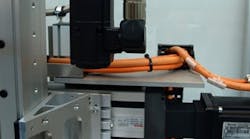Not to worry, says Matt Lecheler, motion control specialist at Beckhoff Automation. "Generally, we boil it down to three specs," he says. "And that would be speed, torque and inertia."
SEE ALSO: Profit From Motor Management Best Practices
One of the three usually is the dominant criteria, he adds. Satisfying it will be the prime objective, and that will drive everything else. Often, it's inertia that's most important, or, more precisely, the inertia ratio between the motor and the load. The closer the total inertia is to an even split between motor and load, the more responsive the overall system will be. To see why, consider two cases, Lecheler says. In one, imagine pushing a car in neutral. In the other, picture doing the same to a baby stroller with brakes off. In the first scenario, you can move the car, but not quickly. And once you get it moving, it can be hard to stop. In the second situation, you can start and stop on a dime.
An analogous example in machine terms might be rotating the fuselage of an airplane versus the pick-and-place of chips going into a printed circuit board. It's a case of tons of inertia versus grams.
The ideal ratio is 1:1. However, in practical terms most applications can function perfectly well with the load having eight times the inertia of the motor, Lecheler says.
He adds that figuring out the inertia of the system can be a complicated affair. There could be gearboxes and other mechanical linkages involved that alter the load's inertia as seen by the motor. Usually, the best solution is to have a software package calculate the perceived inertia of the load, but this might not be necessary for very simple setups.
Commonly, an engineer designing a system needs to achieve a given torque at a particular speed, says Dave Beckstoffer, project manager at Portescap. The company makes a line of miniature motors.
Establishing the torque-speed working point can serve to eliminate a whole host of possible motors. Some could be too slow or not be able to exert enough torque. Occasionally, there might be only one motor that fits the requirements. Typically, though, there will be several. Then other factors can come into play, such as cost or lifetime.
"Life is going to be very important. If you're a machine builder in the medical field, then obviously motor life is going to be critical for you," says Beckstoffer.
A motor that is only projected to last six months in a hospital bedside application would not work, he adds. Often, medical end users would like systems to have lifespans of five or 10 years.
Other possible secondary requirements beyond the speed-torque minimum are feedback, heat, and the need for microprocessor control. Feedback involves whether or not it's necessary to know with certainty if the device moved from point A to B. As for heat, less-efficient motors might generate too much waste heat. The controller issue results in the need of some types of motors to be controlled. That implies a microprocessor is managing the motor's operation, and the processor could already be too busy handling other chores.
Typically, a cruder and more-inexact profile will lead to an oversized motor, Alzayyat says. This means that the energy consumption of the system will be higher than needed, resulting in excess heat generation. That could age components, reducing the lifetime of the system. Thus, there can be a double penalty: higher operating expense due to greater energy usage and sooner-than-necessary component replacement.
Key to getting the motion profile right is calculating continuous versus peak torques. The profile can be further refined by accounting for cycle times. How long does the system have to move from one point to the next, and how long can it take to complete the entire trajectory?
Armed with that knowledge, designers calculate the effect of various movement options and thereby gain an advantage, Alzayyat says. "We can do some optimization that enables you to maybe use a smaller sized motor."
An added benefit of an accurate motion profile is that it can help mitigate technology-specific issues. For instance, permanent magnet motors tend to maintain efficiency over a broader range of speeds and loads than do induction motors. As a result, if speed and load vary over a wider range, a permanent magnet motor might be a better choice. But, the full operating range will be known only if the motion profile is detailed and accurate.
After speed, torque, and inertia ratio are satisfied, then other considerations come into play, says Marcus Hermann, manager of research and development at Johnson Electric. For instance, a growing concern is motor efficiency. This is particularly true for battery-powered applications. In that case, an end user might want the system to run – and do useful work – for an entire day or its lifetime without having to recharge or change batteries. Thus, the motor's energy consumption is important and would need to be specified.
A second trend involves noise. Motors that generate a lot of noise might be less efficient, since they waste energy on something other than work. Vibrations due to friction and mechanical motion also can disturb nearby people and systems.
So, there could be a push to reduce the noise a motor generates. That would join long-standing efforts to improve efficiency, thereby resulting in two secondary motor specs of increasing importance.
As Hermann says, "Energy and the noise issues really are something that I believe will get more and more attention over the next couple of years."
Want more? Get '13 common causes of motor failure'
Motors are used everywhere in industrial environments and they are becoming increasingly complex and technical, sometimes making it a challenge to keep them running at peak performance. Both mechanical and electrical issues can lead to motor failure–and being armed with the right knowledge can mean the difference between costly downtime and improved asset uptime.




